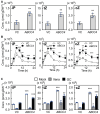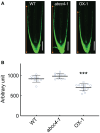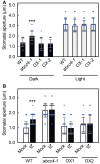The cytokinin efflux transporter ABCC4 participates in Arabidopsis root system development
- PMID: 39719052
- PMCID: PMC11668331
- DOI: 10.1093/plphys/kiae628
The cytokinin efflux transporter ABCC4 participates in Arabidopsis root system development
Abstract
The directional and sequential flow of cytokinin in plants is organized by a complex network of transporters. Genes involved in several aspects of cytokinin transport have been characterized; however, much of the elaborate system remains elusive. In this study, we used a transient expression system in tobacco (Nicotiana benthamiana) leaves to screen Arabidopsis (Arabidopsis thaliana) transporter genes and isolated ATP-BINDING CASSETTE TRANSPORTER C4 (ABCC4). Validation through drug-induced expression in Arabidopsis and heterologous expression in budding yeast revealed that ABCC4 effluxes the active form of cytokinins. During the seedling stage, ABCC4 was highly expressed in roots, and its expression was upregulated in response to cytokinin application. Loss-of-function mutants of ABCC4 displayed enhanced primary root elongation, similar to mutants impaired in cytokinin biosynthesis or signaling, that was suppressed by exogenous trans-zeatin treatment. In contrast, overexpression of the gene led to suppression of root elongation. These results suggest that ABCC4 plays a role in the efflux of active cytokinin, thereby contributing to root growth regulation. Additionally, cytokinin-dependent enlargement of stomatal aperture was impaired in the loss-of-function and overexpression lines. Our findings contribute to unraveling the many complexities of cytokinin flow and enhance our understanding of the regulatory mechanisms underlying root system development and stomatal opening in plants.
© The Author(s) 2024. Published by Oxford University Press on behalf of American Society of Plant Biologists.
Conflict of interest statement
Conflict of interest statement. None declared.
Figures







Similar articles
-
Limitation of Cytokinin Export to the Shoots by Nucleoside Transporter ENT3 and its Linkage with Root Elongation in Arabidopsis.Cells. 2021 Feb 8;10(2):350. doi: 10.3390/cells10020350. Cells. 2021. PMID: 33567681 Free PMC article.
-
Arabidopsis ABCG14 is essential for the root-to-shoot translocation of cytokinin.Proc Natl Acad Sci U S A. 2014 May 13;111(19):7150-5. doi: 10.1073/pnas.1321519111. Epub 2014 Apr 28. Proc Natl Acad Sci U S A. 2014. PMID: 24778257 Free PMC article.
-
Non-intrinsic ATP-binding cassette proteins ABCI19, ABCI20 and ABCI21 modulate cytokinin response at the endoplasmic reticulum in Arabidopsis thaliana.Plant Cell Rep. 2020 Apr;39(4):473-487. doi: 10.1007/s00299-019-02503-0. Epub 2020 Feb 3. Plant Cell Rep. 2020. PMID: 32016506 Free PMC article.
-
Convergence and Divergence of Sugar and Cytokinin Signaling in Plant Development.Int J Mol Sci. 2021 Jan 28;22(3):1282. doi: 10.3390/ijms22031282. Int J Mol Sci. 2021. PMID: 33525430 Free PMC article. Review.
-
Transcriptional and post-transcriptional controls for tuning gene expression in plants.Curr Opin Plant Biol. 2023 Feb;71:102315. doi: 10.1016/j.pbi.2022.102315. Epub 2022 Nov 30. Curr Opin Plant Biol. 2023. PMID: 36462457 Free PMC article. Review.
Cited by
-
Integration of Genetic and Imaging Data to Detect QTL for Root Traits in Interspecific Soybean Populations.Int J Mol Sci. 2025 Jan 28;26(3):1152. doi: 10.3390/ijms26031152. Int J Mol Sci. 2025. PMID: 39940920 Free PMC article.
-
Go with the flow: ABCC4 mediates cytokinin efflux to control root development.Plant Physiol. 2025 Feb 7;197(2):kiaf010. doi: 10.1093/plphys/kiaf010. Plant Physiol. 2025. PMID: 39790020 Free PMC article. No abstract available.
-
Deciphering the molecular logic of WOX5 function in the root stem cell organizer.EMBO J. 2025 Jan;44(1):281-303. doi: 10.1038/s44318-024-00302-2. Epub 2024 Nov 18. EMBO J. 2025. PMID: 39558109 Free PMC article.
-
The Overexpression of ORR3 Negatively Regulates the Growth of Young Rice Roots by Reducing the Cell Size and the Number in the Root Meristematic Zone.Plants (Basel). 2025 May 27;14(11):1627. doi: 10.3390/plants14111627. Plants (Basel). 2025. PMID: 40508302 Free PMC article.
-
Genome-wide identification analysis of the ATP-binding cassette transporter family and expression analysis under methyl jasmonate treatment in Panax ginseng.BMC Plant Biol. 2025 Apr 30;25(1):565. doi: 10.1186/s12870-025-06611-w. BMC Plant Biol. 2025. PMID: 40307704 Free PMC article.
References
-
- Ando E, Ohnishi M, Wang Y, Matsushita T, Watanabe A, Hayashi Y, Fujii M, Ma JF, Inoue S-I, Kinoshita T. TWIN SISTER OF FT, GIGANTEA, and CONSTANS have a positive but indirect effect on blue light-induced stomatal opening in Arabidopsis. Plant Physiol. 2013:162(3):1529–1538. 10.1104/pp.113.217984 - DOI - PMC - PubMed
MeSH terms
Substances
Grants and funding
LinkOut - more resources
Full Text Sources
Miscellaneous

